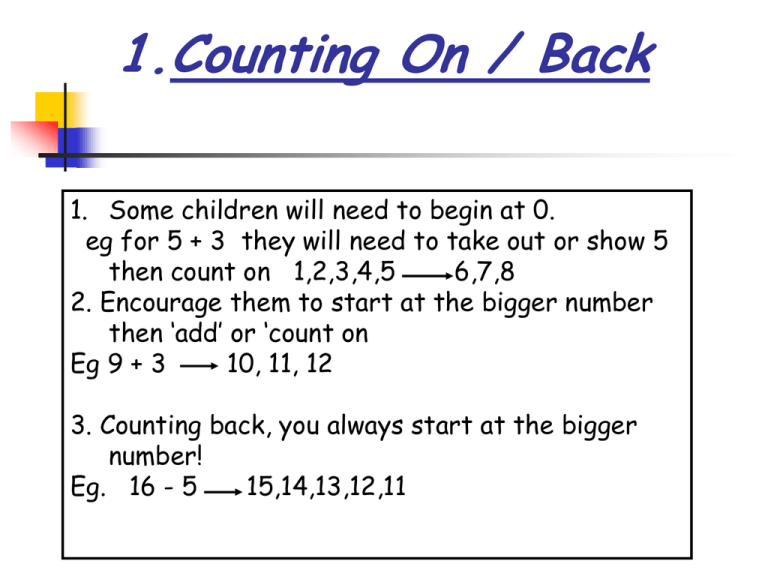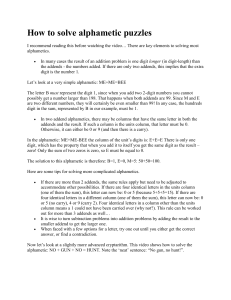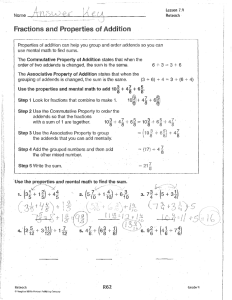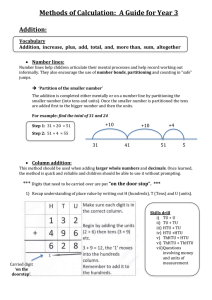Maths Strategies - Harbord Public School
advertisement

1.Counting On / Back 1. Some children will need to begin at 0. eg for 5 + 3 they will need to take out or show 5 then count on 1,2,3,4,5 6,7,8 2. Encourage them to start at the bigger number then ‘add’ or ‘count on Eg 9 + 3 10, 11, 12 3. Counting back, you always start at the bigger number! Eg. 16 - 5 15,14,13,12,11 2. Jump Strategy Number lines are useful, especially with larger numbers. These can be numbered or ‘empty’ 6+5= Eg __|____|____|____|____|____|____|____ 5 6 7 8 9 10 11 OR 34 + 25 __|________|________|___|___|___|___|___| 34 44 54 55 56 57 58 59 3.Doubling or near doubling 1. 6 + 7 is the same as 6 + 6 + 1 6 + 6 or ‘double’ 6 is a known or ‘practised’ number fact 2. 8 + 7 is the same as 8 + 8 - 1 = 16 - 1 = 15 3. 30 + 28 is the same as 30 + 30 - 2 = 60-2 = 58 4. Bridging to 10: 1. For an addition like 9 + 4 Add 1 to 9 first, then 3 more So 9 + 1 + 3 = 13 2. For larger addition facts: 27 + 28 27 + 3 + 25 = 30 + 25 = 55 OR split then bridge 27 + 28 = 20 + 20 + (7 + 8) = 40 + 7 + 3 + 5 = 40 + 15 = 55 OR split, bridge and jump: go to http://www.curriculumsupport.education.nsw.gov.au/primary/mathematics/assets/images/) 5. Trading: Addition Initially done with concrete materials such as iceblock stick bundles or base 10 material so children can ‘see’ how they need to trade You can see this demonstrated at: http://www.allenandunwin.com/teachingmaths/secure /opsense_MABadd.htm#with a) Decomposition: tu 5 43 + 38 81 htu 5 6 456+ 275 731 The expression ‘borrow and pay back’ should not be used. ‘Add ten ones’ and ‘add ten’ is preferable. b) ‘Equal Addends’: htu 69+ 83 152 The expression ‘carry the one’ should not be used. ‘Add ten ones’ and ‘add ten’ is preferable 6. Subtraction: a) Decomposition t u 3 4227 15 ht u 3 456385 71 You can see this demonstrated by going to: http://www.allenandunwin.com/teachingmaths/secure/ opsense_MABsubtract.htm b) Equal Addends h t u 8 1 2693 1 19 The expression ‘borrow and pay back’ should not be used. ‘Add ten ones’ and ‘add ten’ is preferable 1. Firstly add ten ones to units column. This becomes 12-3 which is 9 (units). 2. I must then take off this ten from the tens column. It can be taken from the bottom number as it will give the same answer as if it were taken from the top ie. 10-9 = 11-10. This is what the term ‘equal addends’ means 3. You then repeat the process for the hundreds column.











